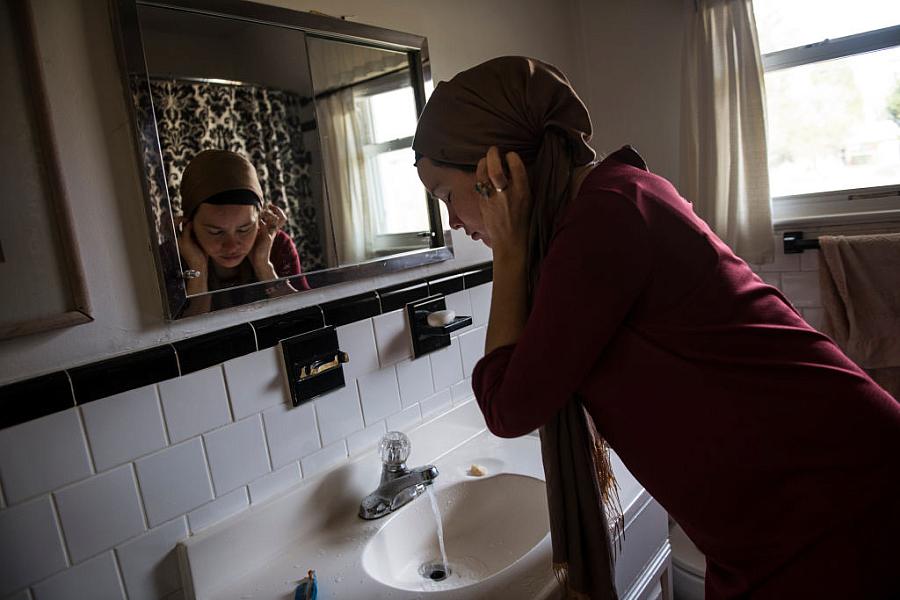Cultural context proves key in reporting on challenges Muslim women face in health care

(Photo by Lynsey Addario/Getty Images Reportage)
My recent story in The Emancipator, “For Muslim women to get the health care they deserve, doctors need to listen,” illuminates the systemic health disparities faced by Muslim women. This story was critical to report given the state of health care in our country, especially for Muslims.
As a Muslim woman reporting on the intersection of faith, gender, and health care, I've found that covering the experiences of Muslim women in the health care system presents unique challenges and valuable lessons.
One of the most significant lessons I learned while working on this project, supported by the 2023 Impact Fund for Reporting on Health Equity and Health Systems, was the importance of deeply understanding the cultural context — the cultural and religious nuances affecting Muslim women's healthcare experiences. This involved not only researching Islamic practices related to modesty, gender interaction, and health-related rituals but also understanding the historical and social contexts in which these women live. I found that investing time in learning about the cultural and religious backgrounds of the communities we report on builds credibility and ensures that our reporting is respectful and accurate.
Building trust within the Muslim community was another significant challenge and accomplishment. I encountered initial skepticism, which is common when dealing with marginalized groups wary of misrepresentation. Establishing relationships with community leaders and organizations proved crucial. To do so, I attended community events, participated in dialogues, and showed genuine interest in the community's well-being. Given that I was part of the community and had done prior reporting helped a lot as well. I learned that trust is built over time through consistent and respectful engagement, and as journalists, we should prioritize these relationships to gain authentic insights and cooperation from the community.
Gaining access to the personal stories and experiences of Muslim women posed its own set of challenges. Many were reluctant to speak out due to fear of stigma or repercussions. To navigate this, I sought to create safe and confidential environments for interviews. Assuring sources of their anonymity and explaining the potential impact their stories could have in driving change helped encourage participation. I learned that using a sensitive and empathetic approach in all interactions is key to gathering honest and impactful testimonies.
To complete my project, I used community engagement to gather diverse perspectives. This included holding focus groups and community conversations, which allowed for a broader range of voices to be heard. I also experimented with participatory journalism methods, where community members actively contributed to the reporting process through open-ended questions. This involved community surveys and collaborative storytelling that required me to pivot if needed. These methods not only enriched the reporting but also empowered the community by giving them a stake in the narrative.
Navigating ethical considerations was paramount throughout this project — obtaining informed consent, protecting the anonymity of vulnerable individuals, and ensuring the accuracy of the reported information were all critical steps. We must be mindful of the potential consequences of our reporting on the individuals and communities involved. This was particularly the case for Muslim women who observed hijab since they face many levels of discrimination.
For other journalists exploring similar subjects, I would emphasize the importance of patience and persistence. Building trust and gathering meaningful insights takes time. Be prepared to revisit sources multiple times and to adapt your approach based on community feedback. Also, consider collaborating with cultural consultants or community liaisons who can provide valuable context and facilitate connections.
Another tip is to look beyond individual stories to identify systemic patterns. While personal narratives are powerful, connecting these to broader trends in healthcare policy, medical education, and societal attitudes can elevate the reporting and potentially drive systemic change.
Lastly, I found it valuable to explore solutions and highlight positive initiatives within the community. Reporting on efforts by Muslim health care professionals to address these challenges, for instance, provided a constructive angle to the story and offered hope to readers.
By focusing on cultural understanding, community trust-building, ethical considerations, and innovative engagement techniques, we can produce well-researched, substantive, and impactful reports that contribute meaningfully to the conversation on health equity and drive positive change in health care practices and policies.
